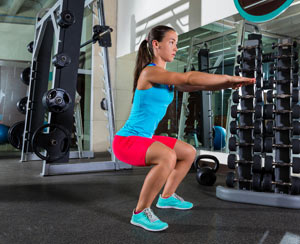 The importance of eating a balanced diet and getting regular exercise have been promoted to the general public for some time now. Consumers seem to be getting the message and are hitting the gym in record numbers. But the health benefits of daily exercise may be hampered by the fact that most consumers’ balanced diets don’t actually include very much real food.
The importance of eating a balanced diet and getting regular exercise have been promoted to the general public for some time now. Consumers seem to be getting the message and are hitting the gym in record numbers. But the health benefits of daily exercise may be hampered by the fact that most consumers’ balanced diets don’t actually include very much real food.
As crazy as that sounds, it’s true. Mechanized farming and genetic modification have actually reduced the overall quality and antioxidant value in many of the fresh fruits and vegetables we consumer. But what’s even worse is that many time-strapped consumers turn to prepackaged, processed foods and drive-thru restaurants for a majority of their meals. This is not real food.
What’s the difference?
Conventionally grown fruits, vegetables and grains are typically genetically modified and use dangerous toxins such as chemical fertilizers and pesticides, and traditionally produced meats and seafood often contain added growth hormones and antibiotics. Consuming such toxins is something everyone should avoid, not just athletes and gym goers.
In addition, processed foods tend to be high in sugar, salt and unhealthy fats, which have been linked to increases in obesity, various diseases and chronic ailments.
However, real foods, such as organic fruits, vegetables and grains, grass-fed meats and wild-caught seafood do not contain any of these toxins, and in some instances may have higher nutritional or antioxidant values.
Why we need real food
Food fuels our bodies, and while the quality of foods we choose is important for everyone, it’s especially important for athletes and exercise enthusiasts who need to replace vital nutrients and energy expended during a workout.
In addition, consuming high levels of antioxidants has been shown to decrease the risk of certain diseases.
What you can do
Increasing your daily intake of real foods isn’t all that difficult. A good place to start is by choosing organic fruits and vegetables. While organic produce can be a little more expensive, it’s easy to mitigate the higher costs by buying what’s in season in your area instead of paying extra for out-of-season produce that had to be transported.
Another good idea is to avoid processed foods whenever possible. While this may mean a bit more meal planning and cooking at home, you’ll likely see an increase in your energy level, which will make it well worth it.
Lastly, try to stay away from foods that are high in unhealthy fats, salt and sugar. This is a tough one for most people, as it usually means avoiding fast food altogether, but you’ll see big improvements on the scale if you’ve been working out in an attempt to lose weight.
For more articles go to http://clubonefitness.lifestyleezine.com

 If you’re like most people, now that summer is finally here you’re probably thinking you should have spent more time at the gym this winter. This may be especially true for anyone who heads to the beach on weekends or lounges poolside during the summer months and wishes they had a firmer butt to show off their new swim suit.
If you’re like most people, now that summer is finally here you’re probably thinking you should have spent more time at the gym this winter. This may be especially true for anyone who heads to the beach on weekends or lounges poolside during the summer months and wishes they had a firmer butt to show off their new swim suit. The classic bench press is a great exercise for building chest muscles, but always repeating the same exercises only targets the same area again and again. To get better results you need to mix it up.
The classic bench press is a great exercise for building chest muscles, but always repeating the same exercises only targets the same area again and again. To get better results you need to mix it up. Dividing up the household chores is one of the most difficult aspects of living with another person. Most people think only newlyweds have this dilemma, but it’s something even older couples, life-long friends and college roommates struggle with when they live together.
Dividing up the household chores is one of the most difficult aspects of living with another person. Most people think only newlyweds have this dilemma, but it’s something even older couples, life-long friends and college roommates struggle with when they live together. You’ve missed out on going to the gym for the second time this week, and you’re starting to feel a little panicked about what will happen to your fitness levels. Even though panicking won’t really help you out here, you may be right to have a little concern.
You’ve missed out on going to the gym for the second time this week, and you’re starting to feel a little panicked about what will happen to your fitness levels. Even though panicking won’t really help you out here, you may be right to have a little concern. Long vacations can be great, but if you lead an active lifestyle, a week’s worth of lounging at some exotic location may not be your idea of the perfect getaway. A better idea might be to plan a bunch of day trips or weekend getaways that let you explore the great outdoors closer to home.
Long vacations can be great, but if you lead an active lifestyle, a week’s worth of lounging at some exotic location may not be your idea of the perfect getaway. A better idea might be to plan a bunch of day trips or weekend getaways that let you explore the great outdoors closer to home. Many men are caught off guard by the physical and mental changes they start to experience somewhere around the age of 30. They are often even more surprised to find out that declining testosterone levels are most likely behind these changes.
Many men are caught off guard by the physical and mental changes they start to experience somewhere around the age of 30. They are often even more surprised to find out that declining testosterone levels are most likely behind these changes.  You eat healthy and work out, but you may be sabotaging all of your good intentions. Recent research suggests that sitting can put you at risk for certain diseases and other health problems, and it can lead to an increase in mortality rates. Yes, sitting-what you might even be doing right now-has been shown to increase a person’s chances of dying.
You eat healthy and work out, but you may be sabotaging all of your good intentions. Recent research suggests that sitting can put you at risk for certain diseases and other health problems, and it can lead to an increase in mortality rates. Yes, sitting-what you might even be doing right now-has been shown to increase a person’s chances of dying. Today’s consumers are taking a closer look at how their food choices might be impacting their health. Nutritionists and food manufacturers have taken note of this trend, responding with an overload of information about which food ingredients consumers should avoid and a wealth of new products claiming to be free from certain ingredients.
Today’s consumers are taking a closer look at how their food choices might be impacting their health. Nutritionists and food manufacturers have taken note of this trend, responding with an overload of information about which food ingredients consumers should avoid and a wealth of new products claiming to be free from certain ingredients. We hear it all the time. Everyone should eat more fruits and vegetables. In fact, the Center for Disease Control suggests that eating a sufficient amount of fruits and vegetables could lower the risk of certain diseases. So why is it that we often reach for a sugary snack or other high-calorie foods when we’re in a hurry and hunger strikes?
We hear it all the time. Everyone should eat more fruits and vegetables. In fact, the Center for Disease Control suggests that eating a sufficient amount of fruits and vegetables could lower the risk of certain diseases. So why is it that we often reach for a sugary snack or other high-calorie foods when we’re in a hurry and hunger strikes?